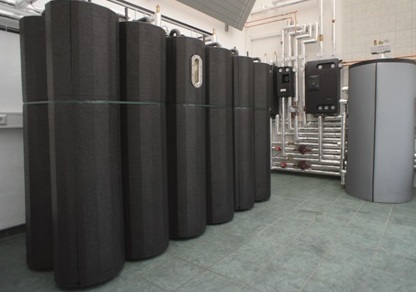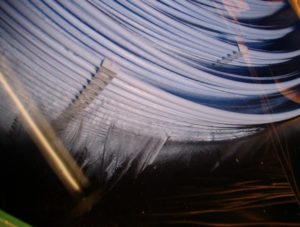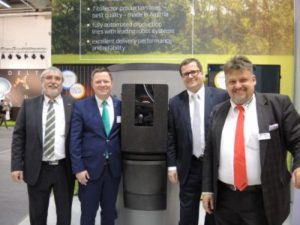Germany: H.M. Heizkörper Plans to Mass-Produce Latent Heat Storage Units
May 13, 2014
 The Thermobatterie (English: thermal battery), a latent heat storage unit by German manufacturer H.M. Heizkörper, makes it possible to absorb generated thermal energy and store up to two-thirds of it as latent heat without time restraints or heat losses. If required, the energy can later be released in suitable amounts and used in different application areas. The other third of the absorbed thermal energy will be stored conventionally as sensible heat, meaning heat that can be felt physically. solarthermalworld.org spoke with Project Manager Michael Sigwanz about the battery’s market potential and target groups and the advantages of a modular design. The photo shows the Thermobatterie in a single-family-house in Büttstedt, Germany.
The Thermobatterie (English: thermal battery), a latent heat storage unit by German manufacturer H.M. Heizkörper, makes it possible to absorb generated thermal energy and store up to two-thirds of it as latent heat without time restraints or heat losses. If required, the energy can later be released in suitable amounts and used in different application areas. The other third of the absorbed thermal energy will be stored conventionally as sensible heat, meaning heat that can be felt physically. solarthermalworld.org spoke with Project Manager Michael Sigwanz about the battery’s market potential and target groups and the advantages of a modular design. The photo shows the Thermobatterie in a single-family-house in Büttstedt, Germany. Photo: H.M. Heizkörper
Solarthermalworld.org: When and for whom will the Thermobatterie be a lucrative investment?
Michael Sigwanz: Individuals and companies profit from Thermobatterie use whenever their installed system produces more energy than can be consumed at the same time. Installing a basic unit can very soon turn out to be a lucrative investment, because the charging process presents you with two options to withdraw heat: with the sensible heat after charging and with the latent heat released during the phase change. The heat is stored as follows: First, salt is melted in about 80°C hot water over three hours. After cooling off, it will stay in its liquid state as “undercooled melt”. Only after the crystallisation process is triggered will the salt become crystalline again and release heat at a temperature of 56°C. Then, the circle can start anew.
The Thermobatterie is primarily suited to systems which require a heat supply between 30°C and 90°C, but mostly around 55°C, for example, heating and hot water systems in residential buildings. The battery can also be an interesting technology to complement a solar thermal system.
Solarthermalworld.org: Based on which criteria do you design a thermal battery?
Michael Sigwanz: During each project, we determine how high the energy yield is compared to the energy demand. This usually results in the energy delta that tells us when the system produces more energy than needed and how much more that is. The data needs to be as detailed as possible, meaning precise measurements for each week or, ideally, for each day. Afterwards, we create an energy utilisation plan listing how often we can charge and discharge the cells of the Thermobatterie. These calculations help us determine the number of units to be installed.
Michael Sigwanz: During each project, we determine how high the energy yield is compared to the energy demand. This usually results in the energy delta that tells us when the system produces more energy than needed and how much more that is. The data needs to be as detailed as possible, meaning precise measurements for each week or, ideally, for each day. Afterwards, we create an energy utilisation plan listing how often we can charge and discharge the cells of the Thermobatterie. These calculations help us determine the number of units to be installed.
Solarthermalworld.org: Is the Thermobatterie a module-based system?
Michael Sigwanz: Yes, it is. The system consists of many individual cylinders. This allows for an optimal size adjustment and makes a retrofit possible as well. In addition, the stored latent energy must be used after melting – that practically calls for storing several, smaller portions. A cell as the smallest unit of a thermal battery consists of four cylinders. In turn, a complete thermal battery contains four cells. We calculate four to ten cells and a space need between 3 and 8 m² for a home of 140 m². Each cylinder has a capacity of 115 kg. Including insulation, it has a diameter of 40 cm and a height of almost 2 m. Its storage capacity is 12 kWh – 8 kWh for latent and 4 kWh for sensible heat.
Michael Sigwanz: Yes, it is. The system consists of many individual cylinders. This allows for an optimal size adjustment and makes a retrofit possible as well. In addition, the stored latent energy must be used after melting – that practically calls for storing several, smaller portions. A cell as the smallest unit of a thermal battery consists of four cylinders. In turn, a complete thermal battery contains four cells. We calculate four to ten cells and a space need between 3 and 8 m² for a home of 140 m². Each cylinder has a capacity of 115 kg. Including insulation, it has a diameter of 40 cm and a height of almost 2 m. Its storage capacity is 12 kWh – 8 kWh for latent and 4 kWh for sensible heat.
Solarthermalworld.org: Can a Thermobatterie help achieve a solar coverage value of 100 %?
Michael Sigwanz: Normal construction projects, such as renovations, make such a goal seem hardly achievable, but I could see it happening in so-called low-energy houses, provided that the necessary planning was done. The requirement for such high coverage is a big enough solar thermal system and sufficient installation space for the required cells of the Thermobatterie.
Michael Sigwanz: Normal construction projects, such as renovations, make such a goal seem hardly achievable, but I could see it happening in so-called low-energy houses, provided that the necessary planning was done. The requirement for such high coverage is a big enough solar thermal system and sufficient installation space for the required cells of the Thermobatterie.
Solarthermalworld.org: How great are the maintenance requirements compared to conventional solar storage units and how great is the unit’s economic life?
Michael Sigwanz: The storage medium sodium acetate does not need any costly or time-consuming maintenance. The components used – such as the rotary vane, actuator and the sensors – should be inspected at usual maintenance intervals. There is no additional work involved compared to conventional solar storage units. During our pilot and testing phase, we have not discovered any relevant data that would point to a reduction in the unit’s lifetime. The phase change can be repeated indefinitely – as with freezing and melting ice cubes. Since we speak about a physical and not a chemical process, this is one of the most important facts.
Michael Sigwanz: The storage medium sodium acetate does not need any costly or time-consuming maintenance. The components used – such as the rotary vane, actuator and the sensors – should be inspected at usual maintenance intervals. There is no additional work involved compared to conventional solar storage units. During our pilot and testing phase, we have not discovered any relevant data that would point to a reduction in the unit’s lifetime. The phase change can be repeated indefinitely – as with freezing and melting ice cubes. Since we speak about a physical and not a chemical process, this is one of the most important facts.
Solarthermalworld.org: How far is the installation of your new production line for thermal batteries?
Michael Sigwanz: The manufacturing line at our location in Ohrdruf has already been installed and can mass-produce the cylinders fully automated. It takes the cylinders’ outer hulls off the aluminium coil and welds them into a cylindrical shape, then adds the other components and welds them together right down to the millimetre.
Michael Sigwanz: The manufacturing line at our location in Ohrdruf has already been installed and can mass-produce the cylinders fully automated. It takes the cylinders’ outer hulls off the aluminium coil and welds them into a cylindrical shape, then adds the other components and welds them together right down to the millimetre.
Solarthermalworld.org: Have you already started mass-production?
Michael Sigwanz: So far, we have not produced in high quantities, because the additional data and results we gathered during the pilot and testing phase have been directly incorporated into the further development of our battery. The Thermobatterie is not on the market yet, so that mass-production hasn’t been necessary either. We hope that we can announce a launch date at the end of the year. After we have done that, we will start mass production in Ohrdruf.
Michael Sigwanz: So far, we have not produced in high quantities, because the additional data and results we gathered during the pilot and testing phase have been directly incorporated into the further development of our battery. The Thermobatterie is not on the market yet, so that mass-production hasn’t been necessary either. We hope that we can announce a launch date at the end of the year. After we have done that, we will start mass production in Ohrdruf.
Solarthermalworld.org: How would you evaluate the current acceptance of latent heat storage technologies on the market and with which measures would you think one could increase the technology’s popularity and expand its application?
Michael Sigwanz: When we were taking part in the SHK Essen, the Energy Storage Düsseldorf, the IFH Nürnberg and the Hanover Fair, we again saw how great the demand for storage systems actually is. It didn’t matter much whether we spoke to a homeowner, a technical manager of a housing company or to businesspeople and politicians: All of them were looking for solutions and ideas. Our big advantage is the modularity of our system and its flexibility. The greater the current transformation of the energy sector will increase demand, the greater the acceptance will be. Last year, the federal state of North Rhine-Westphalia was the first to try and make latent storage systems attractive by initiating the progres.nrw programme. We use the contacts and distribution channels that we built up through our main business of selling radiators to try to inform people about the technology. Adding to that are prominent reference projects, such as the one at the University Düsseldorf or the primary school in Halle/Saale. And, of course, our brand also benefits from awards, such as the Innovation Award Thuringia or the E.ON Energy Efficiency Prize.
Michael Sigwanz: When we were taking part in the SHK Essen, the Energy Storage Düsseldorf, the IFH Nürnberg and the Hanover Fair, we again saw how great the demand for storage systems actually is. It didn’t matter much whether we spoke to a homeowner, a technical manager of a housing company or to businesspeople and politicians: All of them were looking for solutions and ideas. Our big advantage is the modularity of our system and its flexibility. The greater the current transformation of the energy sector will increase demand, the greater the acceptance will be. Last year, the federal state of North Rhine-Westphalia was the first to try and make latent storage systems attractive by initiating the progres.nrw programme. We use the contacts and distribution channels that we built up through our main business of selling radiators to try to inform people about the technology. Adding to that are prominent reference projects, such as the one at the University Düsseldorf or the primary school in Halle/Saale. And, of course, our brand also benefits from awards, such as the Innovation Award Thuringia or the E.ON Energy Efficiency Prize.
More information:


